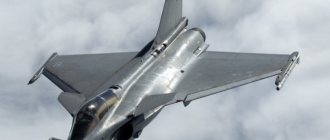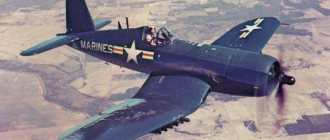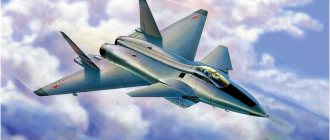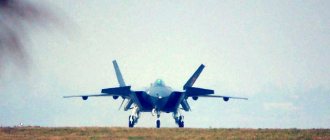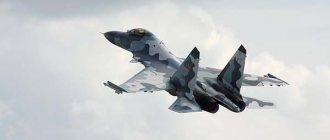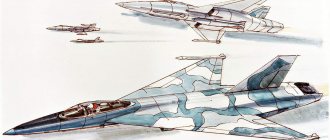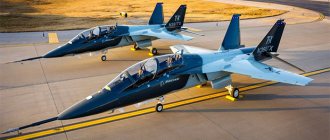Su-27
Soviet and Russian multi-role heavy supersonic fighter of the 4th generation, can be operated in any weather conditions. Designed to establish air superiority over the enemy. Used to launch missile and bomb attacks on ground targets. They also have nuclear weapons in service.
The Su-27 is not only one of the main fighters of the Russian Air Force; modifications of the aircraft are in service with the armies of China, India, and the CIS countries. Based on it, combat training, carrier-based, multi-role fighters, and bombers were produced. As of 2022, the Su-27 ranks 3rd in popularity among combat aircraft worldwide and 1st in popularity among aircraft manufactured in Russia. In service there are a maximum of 6 air-to-air missiles with radar and 2 with heat-seeking, up to 6 close-range missiles.
Second round: popular vote
This round is simple. Other countries vote using rubles, dollars, francs or other currencies. More sales - more points. However, there are nuances.
France: Dassault-Rafale
The cost of this fighter is 85-124 million dollars. Yes, it’s not cheap, but sales were boosted by winning the “mother of all tenders” - the Indian MMRCA (Medium Multi-Role Combat Aircraft, “medium multi-role combat aircraft.” - Ed.). 36 units were pushed into Qatar and 24 into Egypt. Well, India itself seems to have already swung to 36 French “squalls” (it was planned, however, 126, but these are already details).
Dassault Rafale (photo: Gauthier Bonnet)
Germany, Italy, Spain and Great Britain: Eurofighter Typhoon
The price is steep: somewhere around 120 million per carcass. However, a merchant was found for this product. In addition to the countries that participated in the creation (here the rule is ironclad: if you participated in the cooking, you will eat it), “typhoons” were acquired by Austria, Saudi Arabia and Oman. The delivery process to Qatar and Kuwait has also begun. In total, more than six hundred aircraft will delight their owners.
SAAB JAS-39 "Gripen" (photo: Tony Osborne)
Sweden: SAAB JAS-39 "Gripen"
Despite the very sweet price of $48 million, there are not many buyers. And the buyers here are different: they take the last thing out of their pockets, bargain, and hope for a discount. Hungary, the Czech Republic, South Africa and Thailand entrusted their skies to Swedish aircraft, but it is worth considering that some were unable to buy and agreed to lease the aircraft. Switzerland also wanted to have “griffins”, but the popular vote was against it.
But then things got better: we won a Brazilian tender, under which deliveries can soon begin. Bulgaria will purchase several pieces.
Ratings:
Dassault Rafale - 3.5
Eurofighter Typhoon - 4.5
JAS 39 Gripen - 3.5
MiG-35
New Russian light fighter. Belongs to the 4++ generation, with characteristics as close as possible to the 5th generation. Designed to establish air superiority and use high-precision weapons to deliver effective strikes against surface and ground targets outside the enemy's air defense zone.
Entered into service in 2022. Developed by modernizing the MiG-29M/M2 and MiG-29K/KUB, the model received improved performance characteristics, increased its versatility and combat effectiveness. The aircraft has become more economical, cheaper, and stealth has improved.
Links[edit]
Quotes [edit]
- ^ a b c d Baker 2018
- ^ ab Dr. Richard P. Hallion (Winter 1990), Air Force Fighters Acquired Since 1945, "Air Power Magazine", archived from the original on December 11, 2016, retrieved February 7, 2012.
- John W. R. Taylor and John F. Gilmartin; "Warplanes: The Jet Age", britannica.com. (Accessed January 3, 2021)
- Steve Garber; Quest for Performance: The Evolution of Modern Aircraft
, NASA SP-468, NASA History Office, Updated August 6, 2004. Chapter 11, pages 2-6. (Retrieved January 3, 2022) - ↑
Winchester 2011, pages 5, 83. - ^ abc Jo Yoon (June 27, 2004). "Generation Buster". Aerospaceweb.
- Richard A. Bitzinger, ed. (2009). The Modern Defense Industry: Political, Economic and Technological Issues. Praeger. paragraph 307.
- "Five generations of aircraft". Fighter World Aviation Museum, Australia.
- ^ abc "Five Generations of Jet Fighters" (PDF). Bulletin of the Center for Aviation Energy Development
. Royal Australian Air Force. January 2012 - "What is a 5th Generation Fighter" (PDF). Eurofighter World
. February 2010. p. 16. Archived from the original (PDF) on November 2, 2012. (archive date is determined from the archive URL) - ↑
Daniel Leblanc (October 18, 2013). "Aircraft replacement war heats up between Lockheed Martin and Boeing". "Globe and Post Office". - ↑
Bill Sweetman (March 24, 2014). "Is Saab's new Gripen the future of fighter jets?" . "Aviation Week and Space Technologies". - ^ abc John A. Tirpak (October 2009). "Sixth generation fighter". "BBC Magazine". Archived March 3, 2016.CS1 maint: bot: original URL status unknown (link)
- Winchester 2011
- “Is the Chinese J-20 competitive with other stealth fighters?” . Chinese power
. CSIS. Retrieved April 30, 2022. - ↑
Baker 2022, Chapter 1: Generational Genesis. - Jump up
↑ Baker 2022, Chapter 2: Generation Gap. - Jump up
↑ Baker 2022, Chapter 3: Generation Rising. - ↑
Baker 2022, chapters 4 to 6. - ↑
Baker 2022. Chapter 9: MiG-35. - Baker 2022, chapters 7 to 14.
- ↑
Baker 2022, Chapter 18.
Bibliography[edit]
- David Baker; Fifth generation fighters
, Mortons, 2022. - Jim Winchester (December 15, 2011). Jet fighters inside and out. Weapons of war. New York: Rosen Publishing Group. ISBN 978-1448859825.
| vteGenerations of fighters | |
| |
MiG-31
Soviet and later Russian all-weather supersonic interceptor fighter. The first 4th generation combat aircraft of the USSR, developed back in the 1970s on the basis of the MiG-25. Unlike the prototype, the MiG-31 became a 2-seater.
The purpose of the aircraft is to intercept and destroy air targets at different altitudes, at any time of the day, in any weather conditions, when the enemy uses false thermal targets and radar interference.
A group of 4 MiG-31 units can control a significant area.
The fighter was developed to intercept aircraft missiles at any speed and altitude, to destroy low-flying satellites and drifting balloons that NATO had launched over the territory of the Soviet Union since the 50s. Armament: 6-barreled automatic cannon, with a set of 260 shells, 4 long-range guided missiles (120 km).
Second generation[edit]
The Korean War of 1950-1953 forced a major rethink. The guns proved unsuitable for operation at such high speeds, while the need for multi-role battlefield support was rediscovered. The interceptors that emerged after the war used afterburning engines to provide Mach 2 performance, while radar and infrared homing missiles greatly improved their accuracy and firepower. American Century series such as the Lockheed F-104 Starfighter, Russian MiG-21, English Electric Lightning and French Dassault Mirage III were typical of this era. Many types were soon compromised by adaptation to support roles on the battlefield, and some would persist in new variants for several generations.[17]
Su-35
Ultra-maneuverable multi-role fighter of the 4++ generation. One of the main aircraft of this type in the Russian Air Force. Produced by modernizing the Su-27. The differences in design with the prototype are as follows: a reinforced airframe, no brake flap and no front horizontal tail. Armament of the Su-35: aircraft cannon and 150 shells, medium-range air-to-air missiles - up to 14, short-range - 6 and long-range 4. It is armed with anti-ship air-to-ground missiles, precision-guided and unguided munitions.
American "sixes"
Both here and in the USA they are trying to guess what the 6th generation will be like. And everyone agrees that there is most likely no place for a pilot - the fighter will be a drone. The first draft design was presented on its own initiative by the Northrop Grumman Corporation. The result was a flat and “sleek” aircraft to reduce radar signature, built according to the “flying wing” design, that is, without a tail. In the 6th generation, it is planned to abandon missile weapons and replace them with laser ones. This is not science fiction: in the USSR, such developments were carried out at NPO Almaz, now part of the Almaz-Antey East Kazakhstan Concern. Last year it was reported that this topic was being resumed after a long hiatus. In addition (talk about science fiction!) the “sixes” will probably gain the ability to go into near space. However, when all this is realized, God knows: the pace of adoption of new equipment is clearly slowing down. Only 5 years passed between the first and second generations of fighters, and 35 between the fourth and fifth!
What is the MiG-35 fighter?
More details
The best Russian fighter - Su-57
5th generation multirole fighter, developed by Russian designers as a replacement for the Su-27 heavy fighter. In 2013-2019, production of the serial aircraft began. It is planned to produce 76 units to equip 3 aviation regiments.
Information about the Su-57, for the most part, remains secret, the characteristics are known only approximately. In terms of weight, it belongs to the class of heavy fighters. The characteristics meet the requirements of the 5th generation, high stealth (a combination of Stealth electronic warfare technology is used). The Su-57 has supersonic speed and can perform maneuvers with high overloads.
It is equipped with advanced electronics and automated control. It is capable of being controlled in unmanned mode, even when far from the base, so it is being considered for the creation of new models controlled by artificial intelligence.
The Russian army is armed with several models of fighters. They differ in their characteristics, purpose, and installed weapons.
Fifth generation[edit]
Main article: Fifth generation jet fighter
Tremendous advances in digital computing and mobile networks beginning in the 1990s have led to a new model of C3 (command, control and communications) forward presence over the battlefield. Such aircraft used to be large transport types tailored for this role, but information technology had advanced to the point that a much smaller and more maneuverable aircraft could now carry the necessary data systems. Sophisticated automation and human interface could significantly reduce crew workload, and it was now possible to combine C 3., fighter and ground support in one maneuverable aircraft. Such a fighter—and its pilot—would need to be able to hang around for long periods of time, hold its ground in combat, maintain battlefield awareness, and seamlessly switch between roles as the situation evolves.
A machine like this was made possible by parallel developments in materials, engine technology and electronics. Since the turn of the millennium, advanced systems concepts such as smart helmets, sensor and data fusion, and combat-assisted drones have become a reality. The consolidation and integration of such advances, along with those of the fourth generation, created what became known as the fifth generation of fighter aircraft. The first of these is admittedly the Lockheed Martin F-22. Subsequent types include the Lockheed Martin F-35, Sukhoi T-50/Su-57, Chengdu J-20 and Shenyang FC-31. [21]


